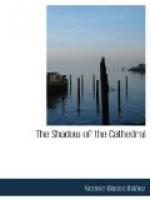Gabriel understood that he had opened some deep wound by his inquiries, and so said no more, beginning once more his ascent. During his absence a terrible event had happened in his brother’s life—one of those events that break up a family and separate for ever those that survive.
They crossed the gallery covered by the archbishop’s archway and entered the upper cloister called “the Claverias”: four arcades of equal length to those of the lower cloister, but quite bare of decoration, and with a poverty-stricken aspect. The pavement was chipped and broken, the four sides had a balustrade running round between the flat pillars that supported the old beams of the roof. It had been a provisional work three hundred years ago, and had always remained in the same state. All along the whitewashed walls, the doors and windows belonging to the “habitacions” of the Cathedral servants opened without order or symmetry. These were transmitted with the office from father to son. The cloister, with its low arcade, looked like a street having houses on one side only; opposite was the flat colonnade with its balustrade, against which the pointed branches of the cypresses in the garden rested. Above the roof of the cloister could be seen the windows of another row of “habitacions,” for nearly all the dwellings in the Claverias had two stories.
It was the population of a whole town that lived above the Cathedral, on a level with its roofs; and when night fell, and the staircase of the tower was locked, it remained quite isolated from the city. This semi-ecclesiastical tribe was born and died in the very heart of Toledo without ever going down into the streets, clinging with traditional instinct to the carved mountain of stone, whose arches served it as a refuge. They lived saturated with the scent of incense, breathing the peculiar smell of mould and old iron belonging to ancient buildings, and with no more horizon than the arches of the bell tower, whose height soared into the small patch of blue sky visible from the cloister.
The “companion” Luna thought he was returning with one step to the days of his childhood. Little children like the Gabriel of former days were playing about the four galleries, and sitting in that part of the cloister bathed by the first rays of the sun. Women, who reminded of his mother, were shaking the bedclothes out over the garden, or sweeping the red bricks opposite their dwellings; everything seemed the same. Time had left it quite alone, evidently thinking there was nothing there that he could possibly age. The “companion” could now see two sketches of lay brothers that he had drawn with charcoal when he was eight years old; had it not been for the children one might have thought that life had been suspended in that corner of the Cathedral, as though this aerial population could neither be born nor die.
The “Wooden Staff,” frowning and gloomy since the last words were spoken, tried to give some explanation to his brother.




